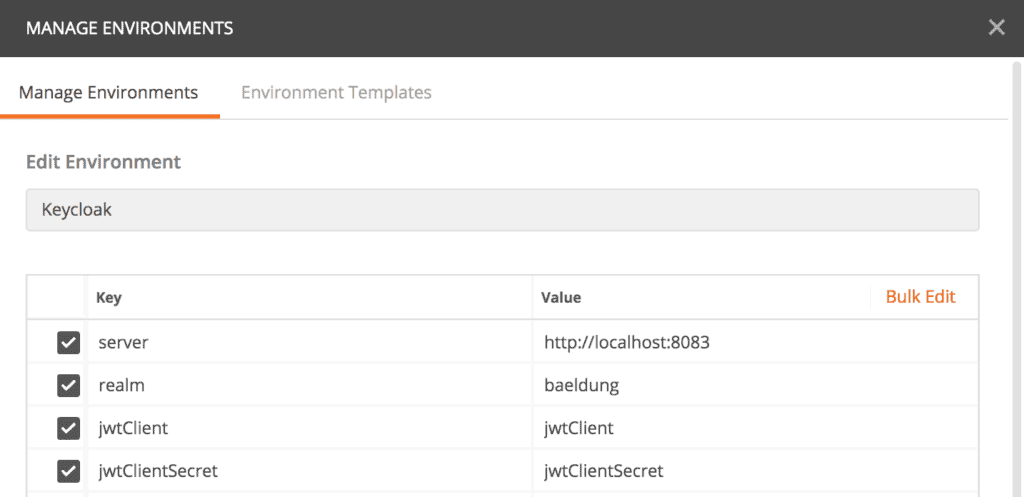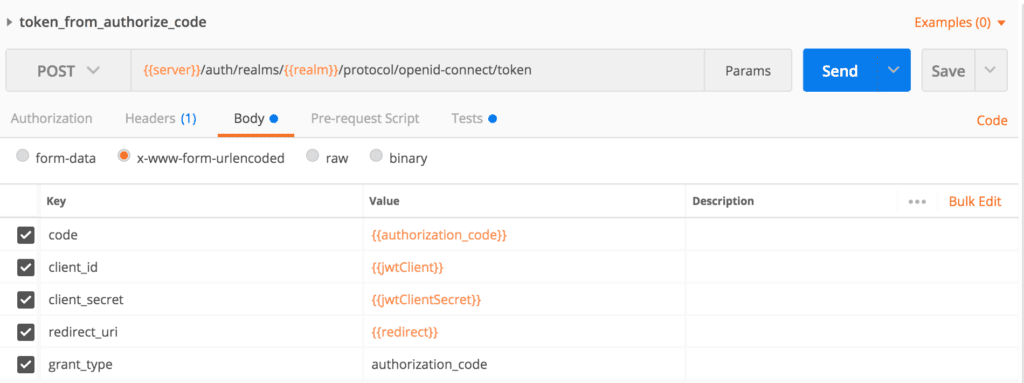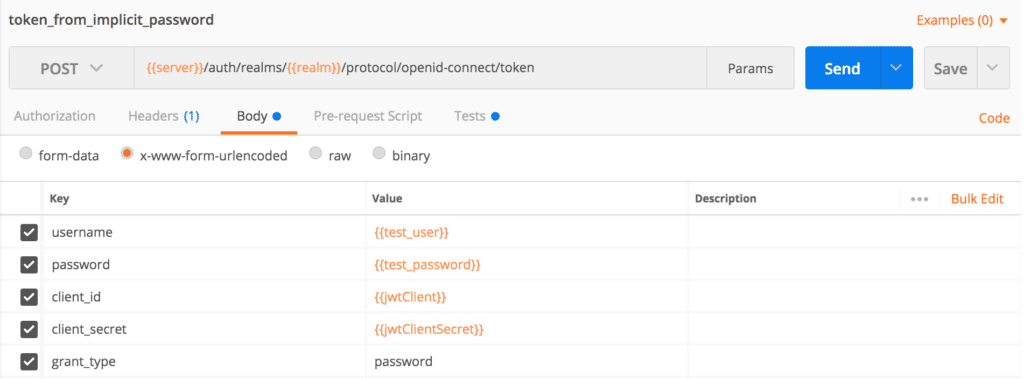1. Introduction
In this tutorial, we’ll start with a quick review of OAuth 2.0, OpenID, and Keycloak. Then we’ll learn about the Keycloak REST APIs and how to call them in Postman.
2. OAuth 2.0
OAuth 2.0 is an authorization framework that lets an authenticated user grant access to third parties via tokens. A token is usually limited to some scopes with a limited lifetime. Therefore, it’s a safe alternative to the user’s credentials.
OAuth 2.0 comes with four main components:
- Resource Owner – the end-user or system that owns a protected resource or data
- Resource Server – the service exposes a protected resource, usually through an HTTP-based API
- Client – calls the protected resource on behalf of the resource owner
- Authorization Server – issues an OAuth 2.0 token and delivers it to the client after authenticating the resource owner
OAuth 2.0 is a protocol with some standard flows, but we’re especially interested in the authorization server component here.
3. OpenID Connect
OpenID Connect 1.0 (OIDC) is built on top of OAuth 2.0 to add an identity management layer to the protocol. Hence, it allows clients to verify the end user’s identity and access basic profile information via a standard OAuth 2.0 flow. OIDC has introduced a few standard scopes to OAuth 2.0, like openid, profile, and email.
4. Keycloak as Authorization Server
JBoss has developed Keycloak as a Java-based open-source Identity and Access Management solution. Besides the support of both OAuth 2.0 and OIDC, it also offers features like identity brokering, user federation, and SSO.
We can use Keycloak as a standalone server with an admin console or embed it in a Spring application. Once we have our Keycloak running in either of these ways, we can try the endpoints.
5. Keycloak Endpoints
Keycloak exposes a variety of REST endpoints for OAuth 2.0 flows.
To use these endpoints with Postman, we’ll start by creating an Environment called “Keycloak.” Then we’ll add some key/value entries for the Keycloak authorization server URL, the realm, OAuth 2.0 client id, and client password:

Finally, we’ll create a collection where we can organize our Keycloak tests. Now we’re ready to explore available endpoints.
5.1. OpenID Configuration Endpoint
The configuration endpoint is like the root directory. It returns all other available endpoints, supported scopes and claims, and signing algorithms.
Let’s create a request in Postman: {{server}}/auth/realms/{{realm}}/.well-known/openid-configuration. Postman sets the values of {{server}} and {{realm}} from the selected environment during runtime:

Then we’ll execute the request, and if everything goes well, we’ll have a response:
{
"issuer": "http://localhost:8083/auth/realms/baeldung",
"authorization_endpoint": "http://localhost:8083/auth/realms/baeldung/protocol/openid-connect/auth",
"token_endpoint": "http://localhost:8083/auth/realms/baeldung/protocol/openid-connect/token",
"token_introspection_endpoint": "http://localhost:8083/auth/realms/baeldung/protocol/openid-connect/token/introspect",
"userinfo_endpoint": "http://localhost:8083/auth/realms/baeldung/protocol/openid-connect/userinfo",
"end_session_endpoint": "http://localhost:8083/auth/realms/baeldung/protocol/openid-connect/logout",
"jwks_uri": "http://localhost:8083/auth/realms/baeldung/protocol/openid-connect/certs",
"check_session_iframe": "http://localhost:8083/auth/realms/baeldung/protocol/openid-connect/login-status-iframe.html",
"grant_types_supported": [...],
...
"registration_endpoint": "http://localhost:8083/auth/realms/baeldung/clients-registrations/openid-connect",
...
"introspection_endpoint": "http://localhost:8083/auth/realms/baeldung/protocol/openid-connect/token/introspect"
}
As mentioned before, we can see all the available endpoints in the response, such as “authorization_endpoint,” “token_endpoint,” and so on.
Moreover, there are other useful attributes in the response. For example, we can figure out all the supported grant types from “grant_types_supported” or all the supported scopes from “scopes_supported.”
5.2. Authorize Endpoint
Let’s continue our journey with the authorize endpoint responsible for OAuth 2.0 Authorization Code Flow. It’s available as “authorization_endpoint” in the OpenID configuration response.
The endpoint is:
{{server}}/auth/realms/{{realm}}/protocol/openid-connect/auth?response_type=code&client_id=jwtClient
Moreover, this endpoint accepts scope and redirect_uri as optional parameters.
We won’t use this endpoint in Postman. Instead, we usually initiate the authorization code flow via a browser. Then Keycloak redirects the user to a login page if no active login cookie is available. Finally, the authorization code is delivered to the redirect URL.
Next we’ll see how to obtain an access token.
5.3. Token Endpoint
The token endpoint allows us to retrieve an access token, refresh token, or id token. OAuth 2.0 supports different grant types, like authorization_code, refresh_token, or password.
The token endpoint is: {{server}}/auth/realms/{{realm}}/protocol/openid-connect/token
However, each grant type needs some dedicated form parameters.
We’ll first test our token endpoint to obtain an access token for our authorize code. We’ll have to pass these form parameters in the request body: client_id, client_secret, grant_type, code, and redirect_uri. The token endpoint also accepts scope as an optional parameter:

If we want to bypass the authorization code flow, the password grant type is our choice. Here we’ll need user credentials, so we can use this flow when we have a built-in login page on our website or application.
Let’s create a Postman request and pass the form parameters client_id, client_secret, grant_type, username, and password in the body:

Before executing this request, we have to add the username and password variables to Postman’s environment key/value pairs.
Another useful grant type is refresh_token. We can use this when we have a valid refresh token from a previous call to the token endpoint. The refresh token flow requires the parameters client_id, client_secret, grant_type, and refresh_token.
We need the response access_token to test other endpoints. To speed up our testing with Postman, we can write a script in the Tests section of our token endpoint requests:
var jsonData = JSON.parse(responseBody);
postman.setEnvironmentVariable("refresh_token", jsonData.refresh_token);
postman.setEnvironmentVariable("access_token", jsonData.access_token);

We can retrieve user profile data from the user information endpoint when we have a valid access token.
The user information endpoint is available at: {{server}}/auth/realms/{{realm}}/protocol/openid-connect/userinfo
Now we’ll create a Postman request for it, and pass the access token in the Authorization header:

Then we’ll execute the request. Here’s the successful response:
{
"sub": "a5461470-33eb-4b2d-82d4-b0484e96ad7f",
"preferred_username": "[email protected]",
"DOB": "1984-07-01",
"organization": "baeldung"
}
5.5. Token Introspect Endpoint
If a resource server needs to verify that an access token is active or wants more metadata about it, especially for opaque access tokens, then the token introspect endpoint is the answer. In this case, the resource server integrates the introspect process with the security configuration.
We’ll call Keycloak’s introspect endpoint: {{server}}/auth/realms/{{realm}}/protocol/openid-connect/token/introspect
Then we’ll create an introspect request in Postman, and pass client_id, client_secret, and token as form parameters:

If the access_token is valid, then we’ll have our response:
{
"exp": 1601824811,
"iat": 1601824511,
"jti": "d5a4831d-7236-4686-a17b-784cd8b5805d",
"iss": "http://localhost:8083/auth/realms/baeldung",
"sub": "a5461470-33eb-4b2d-82d4-b0484e96ad7f",
"typ": "Bearer",
"azp": "jwtClient",
"session_state": "96030af2-1e48-4243-ba0b-dd4980c6e8fd",
"preferred_username": "[email protected]",
"email_verified": false,
"acr": "1",
"scope": "profile email read",
"DOB": "1984-07-01",
"organization": "baeldung",
"client_id": "jwtClient",
"username": "[email protected]",
"active": true
}
However, if we use an invalid access token, then the response will be:
{
"active": false
}
6. Conclusion
In this article, with a running Keycloak Server, we created Postman requests for the authorization, token, user information, and introspect endpoints.
As always, the complete examples of the Postman requests are available over on GitHub.













